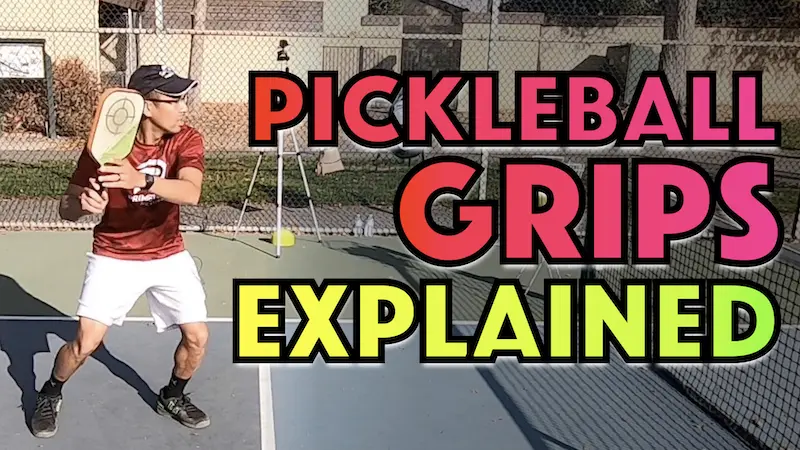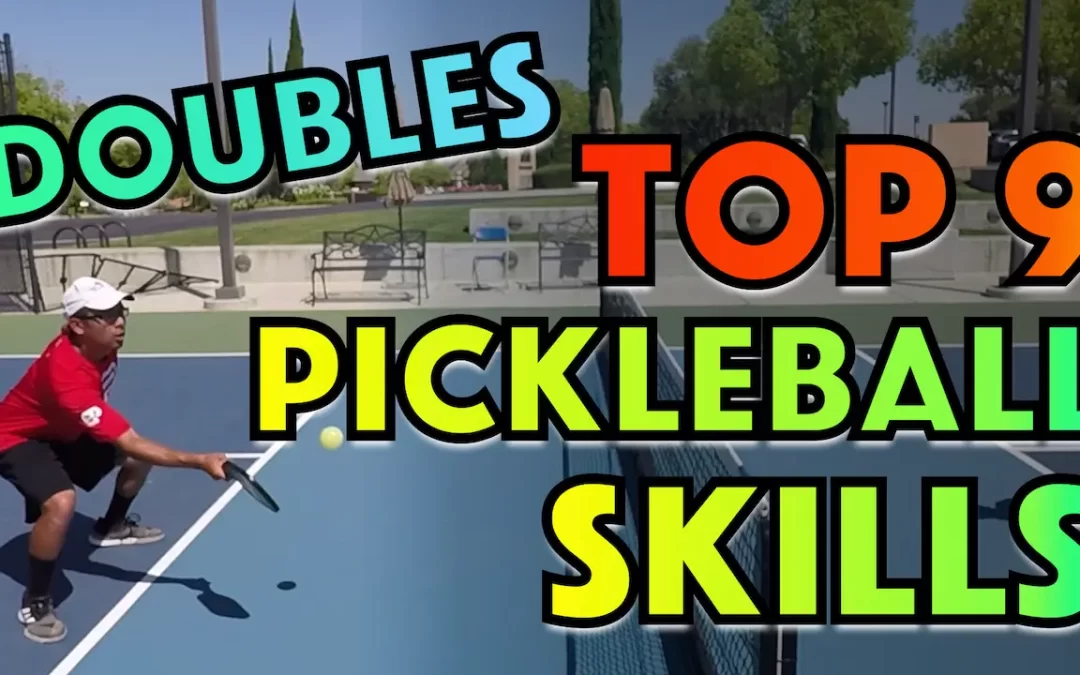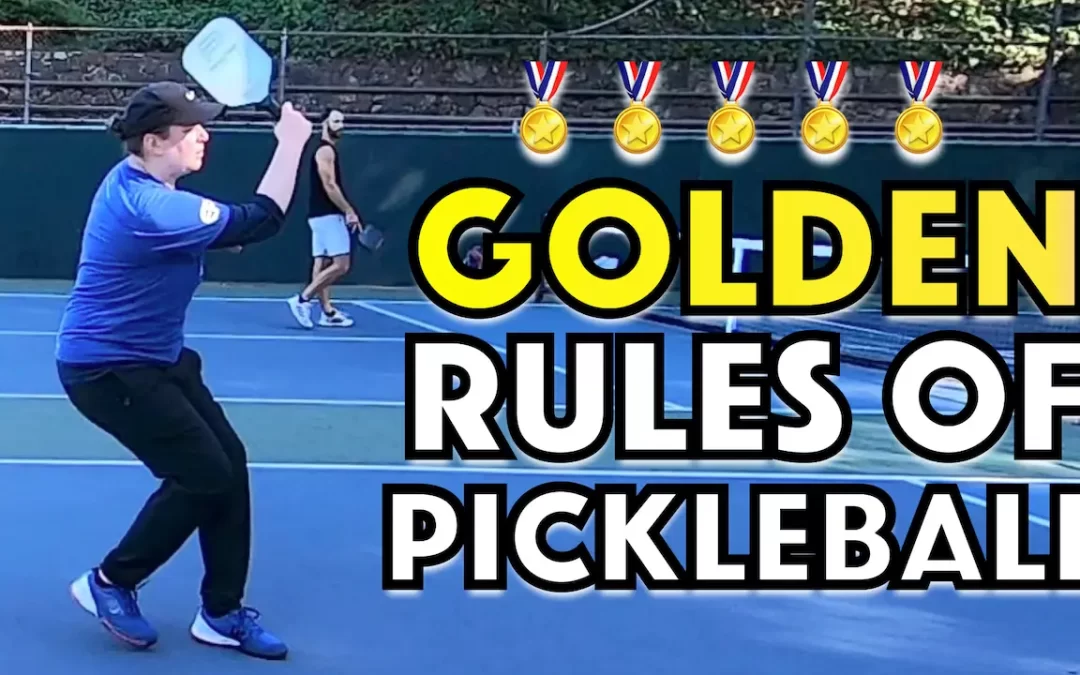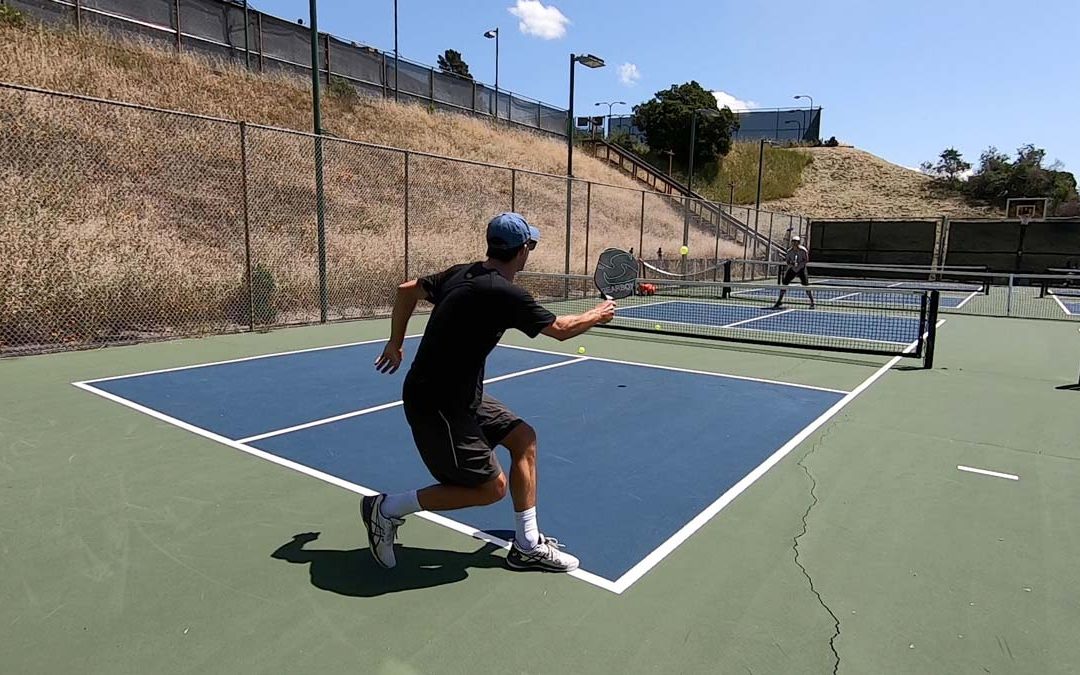Whether you are a complete beginner or new to racket sports, pickleball rules can quickly be learned but take time to master. Whether you have historically viewed yourself as an athlete or not, it is the kind of game where players of all levels of skill and athleticism can enjoy.
However, as a pickleball beginner, it may feel daunting to take on a new sport with little to no information. Knowing the who, what, where, when, and why can make the transition into pickleball much smoother.
Are you ready to learn more about playing pickleball? Let’s go…
Pickleball History & Basics Of The Game
Its important to see where the sport got its start, so you can get an idea of the spirit of the game.
Dads Being Dads
Three dads, Joel Pritchard, Bill Bell, and Barney McCallum, invented the game of pickleball in the summer of 1965. The three fathers, at the time, resided on Bainbridge Island, located just outside of Seattle, Washington.
This game has been dubbed as one of the fastest-growing sports in the United States with approximately 4.8 million players as of 2022.
Pritchard and Bell wanted to keep the kids busy and realized the property on which they were vacationing had an old badminton court. They quickly searched for equipment to play with but could only find table tennis paddles and a perforated plastic ball.
The two men lowered the net from 60 to 36 inches after realizing how easily the ball could be bounced over the net. The third dad, McCallum, joined and the trio invented the rules for the game, relying heavily on badminton rules to formulate the outline.
The ultimate goal behind the rules of the pickleball game was that pickleball would be a family-friendly game.
Pickleball is a fun game, but can also be an aggressive & competitive game.
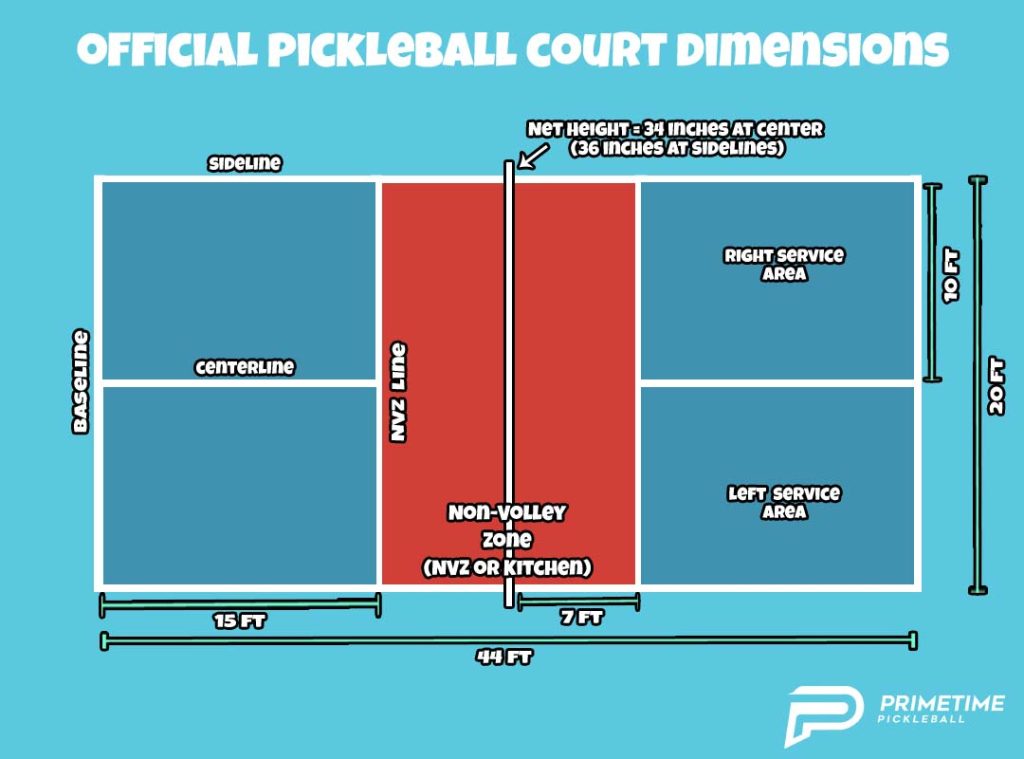
Just Get Started
If you are in a rush, the basics will help you get started, but definitely read through the entire article for more tips. At the very least, you need a court, paddle and ball.
The Court
The pickleball court is one-third the size of a tennis court, but it has the same dimensions as a badminton-sized court.
The dimensions of the court are 20 inches by 44 inches for both singles and doubles courts. The net is 34 inches in the middle and 36 inches at the ends.
Pickleball Equipment
Pickleball is played with a paddle and perforated ball. The paddle is similar to an over-sized ping-pong ball.
More often than not, new pickleball players fall under the misconception that they need a less expensive, beginner’s paddle instead of simply just investing in a good-quality paddle. This is not necessarily the case. Definitely avoid wooden paddles, they’re heavy, clunky and just don’t perform well.
Get what is called a “composite” paddle which is just a fancy way of saying made from multiple materials… mainly plastics, graphite and lately carbon fiber or some combination of those. Get something in the $80-$120 range and you should be just fine and have a good quality paddle that feels good to play with.
If you’re hesitant to invest right at the start, which is understandable, borrow a paddle from a local pickleball ambassador or friendly local player. Pickleball enthusiasts often have tons of used paddles that are still in great condition and that they’d probably be happy to loan out to a beginner that’s just testing the waters.
As far as balls go, they come in two categories: indoor and outdoor. For the full scoop on pickleballs as far as the difference and which balls to get, this article has all the details.
Pickleball Rules You Need to Know
The United States of America Pickleball Association (USAPA) was formed in 2005 and updates the pickleball rules book regularly. There are a few rules in pickleball that all pickleball players should be familiar with before getting onto the court.
Basic Rules of The Game
- Pickleball can be played as a singles game or a doubles game. However, doubles is more popular.
- The rules for doubles and singles are the same but scoring is slightly different for each.
- The game is usually played to 11 points and wins by 2 points.
The Double Bounce Rule
When a ball is served it must bounce twice, once on each team’s side of the court, before it can be volleyed.
For example, the serving team will serve the ball into the service area of the opponent’s side of the court, the ball must bounce once before the returner hits it back over to the serving team’s court, where the ball has to bounce once again. That is where the two-bounce rule came to be known.
After the ball has bounced twice, once on each court, either team may volley the ball. Alternatively, either team may play the ball off a bounce if they wish, also known as a groundstroke.
The double-bounce rule extends rallies and eliminates what would be a distinct advantage for the serving team if they were allowed to serve and volley.
The Non-Volley Zone
The non-volley zone is also often referred to as the kitchen. This is the area that is seven feet from the net, on either side of the. So each player or team has a non-volley zone on their side of the court. Players are prohibited from volleying the ball from within the kitchen.
This rule prevents any player from getting right up to the net and smashing from close which would make for very short points and not a lot of fun. The non-volley zone is distinct to pickleball and makes it a much more strategic game.
A player is charged with a fault if the player steps in the no-volley zone, or on the no-volley zone line while volleying a ball. Or, if by momentum, the player touches the no-volley line or lands in the no-volley zone, or any part of their clothing/equipment touches the line or lands in the no-volley zone when they have volleyed.
Alternatively, the player may be in the non-volley zone if they are not volleying the ball.
Faults
The following are are key points about faults:
- Rule violations that cause the game to stop by a dead ball and inevitably end a rally (typically as it relates to not being able to return the ball over the net and in bounds or by stepping in the non-volley zone when volleying)
- In doubles, fault by the receiving team means that the serving team will receive a point. Alternatively, a fault by the serving team will result in the server losing his/her opportunity to serve. If the fault is caused by the second server, this will result in a side-out.
- In singles, since their is no second server, a side-out occurs as soon as the player loses a rally when serving. Scoring points also only occurs when you are the server.
Other more common faults & mistakes include:
- When a player hits the ball out-of-bounds
- When a player hits the ball against the net or the net post
- Not allowing the ball to bounce first before returning the serve
- Returning the ball after it has bounced more than once on your court
- Volleying the ball in the no-volley zone or touching the no-volley zone lines while volleying the ball
Scoring Rules – Singles
The scoring system in singles is very similar to the system in doubles, with the exception that there is no second server.
The ball is always served from the right-hand court when the server’s score is even and from the left-hand court when the server’s score is uneven.
The score of the server determines the serving position of the server. The receiver will line up with the server on the opposite court. For example, if the server’s score is even, the server will serve from the right-hand court and the receiver will line up diagonally from the serve which will put them on their right (even) side as well.
Scoring Rules – Doubles
In doubles, only the serving team can earn points while serving. The receiving side cannot earn points.
The first team serving, at the beginning of a game, will serve the ball diagonally to the opposite court.
After a point is scored, the server will move over to the other side of the court and serve the ball diagonally into the opponent’s court. The serving team will continue to move from one side of their own court to the other and vice versa as each new point is scored.
The serving team only alternates sides when a new point is earned. However, the receiving team does not change sides during the match. Instead, these players keep their position while being on the receiving end.
The first server will continue to serve.
When the first server loses a rally, it will result in the second server on the serving team getting the opportunity to serve. It is only after the second server commits a fault and loses the right to serve that the ball moves to the opposing team.
The server on the right of the opposing team will start to serve. This pattern continues throughout the game.
Calling the score is simpler than it initially seems. In singles, the server calls their score and then the score of the receiver. In doubles, the serving team calls their score, the score of the receiving team, and their player server number, which is either one or two.
The server number will depend on whether the player is the first or second server on that team’s turn to serve. The number is not attached to a player for a whole game. It will depend who is on the right side after a side out has occurred. The player on the right is first to serve whenever a side-out occurs.
Serving
There are various serving rules to be aware of:
Basic Serve
For pickleball beginners, the initial serve should simply be to put the ball in play. It can evolve into a more offensive shot for you over time but need not be so at first. When learning, just get the serve in the service box so the point can get started.
The serve is an underhand swing, making contact with the ball at or below the waist, and at or below the navel. The arm moves in an upward arc when serving.
In addition, the highest tip of the pickleball paddle should be below the wrist when the paddle makes contact with the ball.
Drop Serve
A new rule was implemented on the 25th of January 2021. It is known as the drop serve.
The ball may be dropped from any height and bounce once before contact is made with the paddle in an underhand shot. The key is that there may be no additional force that moves the ball faster, such as throwing the ball, tossing the ball into the drop serve, or releasing the ball with any additional force.
The serving player should hit the ball diagonally into the opposite service court. The player should be standing behind the baseline when hitting the serve as well as between the center line and the sideline.
Other Serves
There are three different kinds of serves that players should be aware of:
- High Soft Serve
- Power Serve
- Soft Angle Serve
The high soft serve is served deep into the opponent’s court by means of a high arc. These serves are usually to throw off the timing of the receiver who has probably been seeing mostly power serves as that is typically the “go to” serve option of most players at is it is quite effective.
Pickleball is a strategic game and incorporating finesse make sense. By continuously hitting harder shots, you will create a pattern that your opponent will easily identify. The high soft serve is a good change-up.
The power serve, on the other hand, is low, fast, and lands deep in the opponent’s court. This shot can be aimed at the forehand corner, the backhand corner, or, alternatively, directly at the opponent.
This serve is excellent if your opponent has a weak backhand. In addition, if the other player is not that fast, this shot will force them to move, and it may be difficult to return the shot if they are not steady on their feet.
The soft angle shot will essentially drop near the kitchen line and the sideline. It is the most challenging of the three shots and will take the ball outside of the court on the bounce. This serve is great for moving your opponent off the edge of the court. But, it works best when it is unexpected so it’s also wise to use it sparingly. When executed properly, it should put your opponent out of position.
Basic Pickleball Equipment to Start
As a new player on the court, there are a few essentials that every pickleball player should have.
The Paddle
Let’s start with the paddle. This is your tool for the trade. Paddle prices range from $20 up to $200. Ignore anything over $200. Paddles of that price exist but aren’t worth it. There are TONS of great paddles under $200. Paddle weights range from six to 14 ounces.
What’s important to note about the paddle is that it comes in different shapes and sizes, and is often made with different types of material. So, which one is the best one for a beginner?
Essentially, the paddle is made of three different materials:
- Wooden paddles
- Composite pickleball paddles
- Graphite paddles
Wooden paddles are cheap paddles and are considered to be the cheapest of the three and also the heaviest. The weight of the paddle is probably the single most important factor when selecting a paddle.
New players who are still unsure of the game may be tempted to purchase a wooden paddle due to the price. The weight of the paddle may affect the game and eventually the desire to continue playing.
I’d recommend to skip over wooden paddles entirely. A friend of mine that was new to the sport showed up with a wooden paddle and I immediately confiscated it. lol! I gave her one of mine to keep. Luckily being in the business of pickleball I have quite a few good paddles laying around. Perks of the job 🙂
Lighter paddles are known to give more control but also less drive, while heavier paddles offer more drive but less control.
The grip size of the paddle is also important. It should fit your hand. A good barometer to be sure you have the right grip size is that there should be just small gap between the tips of your fingers and the base of your thumb when you wrap your hand around the paddle grip. No more than a centimeter of gap should exist. More than that and the grip is too big for you. If your fingers can touch your hand then the grip is too small.
Composite paddles come in various weights and price ranges. Most players in the beginner to intermediate phase should select these paddles due to the price and composite paddle weight. These paddle materials have an enjoyable feel and offer reasonable power and control and a price that’s easy on the wallet.
Graphite and carbon fiber paddles are the most expensive paddles. But, they offer the most control and power. Many experienced players prefer these paddles.
The Pickleball
Players use plastic balls with perforated holes in them that look similar to a whiffle ball but are specific to pickleball.
The holes create less drag, which makes it much easier for these balls to travel through the air. These balls are 2.87 inches to 2.97 inches in diameter. They come in various bright colors. The most popular color is optic yellow,
Also, there is a difference between indoor and outdoor pickleball balls.
Outdoor balls are bigger, have smaller holes, and are made of thicker plastic. This is because of conditions such as wind and the fact that these balls come off the paddle harder and faster. These balls also need to be more durable since they bounce against a rough hard court surface.
Indoor balls are more rubbery and are designed for indoor play on wooden gym floors. If you are playing indoors but the surface is a hard court than you should use an outdoor ball.
The Shoes
Many new players mistakenly believe that it’s ok to where running shoes to play pickleball. This is a big mistake. Running shoes are designed for forward movement only. There is forward running in pickleball but there is also tons of lateral movement and running shoes are terrible for lateral movement.
You should where court shoes to play pickleball. Generally tennis shoes specifically designed for tennis play are best. Not tennis shoes as in a “casual” athletic shoe that is sometimes called a tennis shoe. An actual tennis shoe is what is needed. You can also opt for a basketball shoe, a volleyball shoe or a badminton shoe if you will play mostly on an indoor wooden surface.
Pickeball specific shoes are beginning to spring up more and more. They are very similar and in some cases virtually identical to tennis shoes but focus on a wider base and toebox, as well as a sturdy midsole and outsole.
So Where Do You Play Pickleball?
The Pickleball Court
One of the first things to look out for is a pickleball court in close vicinity.
Alternatively, if there is no pickleball court located near you, you could opt to play on a badminton or basketball court. Some indoor sporting facilities accommodate players by designating a certain area of the indoor facility for the game of pickleball and marking of temporary court lines accordingly as well as using temporary nets.
Locating a Court
If you are new to pickleball and don’t know where to look for a pickleball court near you, there are various options to consider that will help you locate a facility or court where you can play.
Firstly, there is an official website that lists all the pickleball courts across the United States. This list is constantly being updated.
The website, USA Pickleball Places2Play App and Website, allows prospective players to browse local facilities that offer courts to play on.
Many gyms are dedicating entire courts to the game, due to the rising number of players, and the popularity of the game.
Alternatively, prospective players may consider the following places:
- The local community center
- Facebook groups
- Tennis clubs
- Pickleball membership facilities
- private backyard courts
Facebook groups are an especially rich source of information.
Players can find more information on the game, upcoming events, new players looking for teammates, or even just share their newfound passion with other players.
Learning How to Play Pickleball
The first step in learning to play pickleball is to master the basics.
Understand the fundamental rules of the game. Pickleball is a very easy game to learn but a very challenging game to master. The next step is to learn, understand, and master the various shots in the game.
Know how to return a hard fastball. Learn how to read your opponent and find their weaknesses. Learn about your own strengths as a player and how those can be used to your advantage. Become aware of your weaknesses and work to shore them up over time.
Once players have mastered the basics, the next step is to formulate a strategy.
The best way to learn, of course, is by getting out on the court and playing against other players at the same level or slightly higher.
There are various websites that offer great tips and videos to help new players understand the game and how to play it. Players can learn about different kinds of shots, including groundstrokes, volleys, dinks, and third shot drives and drops, as well as the lobs and more.
Check out our article to learn some pickleball drills to level up your game.
Pickleball Strategies To Master
One of the first and most important strategies to master is to play to your own strength and to the opponent’s weakness. This requires a keen eye in order to identify their weakness. From here, you can formulate a strategy.
When you are playing the game, and you see the pickleball heading towards your court, make a shot selection and stick to it. Strive to make a smart selection and one that will give you a chance to execute within your skill set and to an effective target.
Master the “Pickleball Ready” Position
The game can be very fast, especially when you move closer to the net. To achieve this, your body should be in the right position, your knees slightly bent, and your paddle should be in front of your body with your weigh in the balls of your feet.
This stance cuts down on your reaction time as your paddle is ready for any shot you decide to take and your bent knees give you a chance to spring to the ball wherever it may go.
Pickleball Fun Facts | How Did Pickleball Get Its Name?
There are two accounts of how the game got its name. Pickleball was created by combining elements of tennis, ping-pong, and badminton.
The first account is the pickle boat theory. It is believed that the combination of the three games is reminiscent of the pickle boat in crew. The oarsmen are traditionally selected from the leftovers of other boats. Hence, the sport was dubbed pickleball.
The second account states that Joel Pritchard’s dog was named Pickles. In this account, the dog – Pickles – was known for taking the ball and running off with it. And that is why Joel Pritchard named the sport pickleball.
However, according to Joan Pritchard, their dog, Pickles, only became a member of the family two years after the game was invented. It will likely remain a mystery and people tend to pick the story they prefer since there is no consensus on which story is true.
Final Thoughts
Pickleball is a sport that can be enjoyed by anyone which is part of the reason why it is exploding in popularity and shoes no signs of stopping. It can be a friendly game or a competitive game.
New players should look to join up with friends or family who already play the game or should look for pickleball courts closest to them to join a group of players who have the same interest and would be willing to share information, knowledge, and be willing to play together. Taking a beginner class is advisable and there is likely one available near you thanks to the growing popularity of the sport.
What are you waiting for? It may just be the perfect game for you! Get out there and give it a go.


